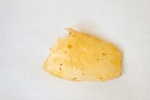 I like to think I learn well from others’ mistakes.
I like to think I learn well from others’ mistakes.
My first introduction to wasabi was when my boyfriend and I went out for authentic sushi, and he took some of the green paste (not knowing what it was) and smeared it all over his sushi like it was guacamole.
After a few seconds of chewing his sushi in what looked like total agony, he downed both his glass of water and mine.
Wasabi, by the way, is Japanese horseradish.
Now, I’ve had horseradish before, during Passover Seder. I know how strong and bitter it is. I’ve witnessed my boyfriend’s reaction to wasabi and heard the story of how his sinuses were on fire for the next hour.
But when I came across wasabi peas in AJ’s, I couldn’t resist.
Apparently I don’t learn from others’ mistakes as well as I’d thought.
When I opened the container, the first thing I did was smell its contents. (Has anyone but me noticed that I seem to have an obsession with smelling food before I eat it? This is such a journey of self-discovery.)
The peas smelled like Chex Mix. I love Chex Mix almost as much as I love indie hard rock, or fuzzy slippers on a cold day. This boded well.
I didn’t throw all caution to the wind based on smell, however. Tempted as I was to stuff a handful of these in my mouth (like I would with Chex Mix at a party, unless someone was looking), the word wasabi emblazoned across a red flag in my mind kept me from doing something so rash.
So I just took one. Gingerly, I put it on my tongue and waited.
About two seconds later, the burning began.
I clamped my mouth shut. I crunched the pea. My tongue wilted.
(All right, so my tongue didn’t wilt. But it felt like it.)
 Hot doesn’t really cover it, nor does spicy. If you’ve ever tried wasabi before, I’m sure you know exactly the sensation I experienced from just one little pea. It burned, it tingled, it hurt… And although I thought I tasted Chex Mix during those first few seconds, that was probably due to my overactive imagination. I wouldn’t know, because any flavor was soon incinerated.
Hot doesn’t really cover it, nor does spicy. If you’ve ever tried wasabi before, I’m sure you know exactly the sensation I experienced from just one little pea. It burned, it tingled, it hurt… And although I thought I tasted Chex Mix during those first few seconds, that was probably due to my overactive imagination. I wouldn’t know, because any flavor was soon incinerated.
After trying one for himself (which he didn’t end up swallowing), my dad commented that maybe these are meant as more of a garnish than a snack — maybe they’re supposed to be put in a salad or something. But no, they’re sold in the snack section, next to the saltwater taffy and the yogurt-covered pretzels. And apparently, they’re a popular snack in Japan.
My dad was right in part, though. AJ’s suggests crushing up these peas to make wasabi pea-rusted ahi tuna steaks (scroll about 2/3 of the way down the page for the recipe). I don’t know when or why I would have a use for this, but I suppose it might be worth a shot…especially since I have a rather large container of peas still sitting on my kitchen table.
The bottom line: Anyone who likes wasabi will probably like these, since the dried peas themselves have no discernible flavor and seem to only serve as a vessel for wasabi paste. (Plus they’re crunchy, I suppose.) These peas pack a punch, and if that’s what you’re looking for, they make a great snack. But if you’re not a fan of spicy food, stay far, far away.
———-
Ingredients: Green peas, corn starch, glutinous rice flour, wheat flour, sugar, soybean and/or palm oil, salt, wasabi, FD&C yellow #5 and blue #1.
Price:$4.49 at A.J’s Fine Foods
Pros: None personally, but for someone who likes excessively spicy food, I’m sure these are great.
Cons: They’re…well, excessively spicy. My tongue still hurts a little.





 Batata
Batata